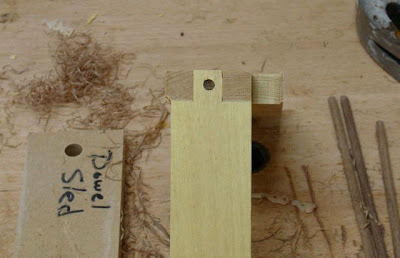An exciting, yet challenging part of woodworking is working with woods that may not want to be worked with! I received a piece of Curly Cherry, along with another piece of Curly Maple, from a woodworker in Virginia. I had shared plans and details with him about making the scrub plane and this was his generous way of "paying it forward". When wood comes from anywhere there is humidity to our dry (2-5%) climate it will tend to react by twisting, cracking, and bowing. A shipment of some exotics came from Woodworkers Source in Phoenix and since their climate is similar to ours
usually it's not a problem but we'll see!
The first step to taming the curly Cherry was to cut it into smaller pieces, that way it seems to be easier to locate the highs and lows of the wood with winding sticks:
 |
| Checking with Winding Sticks |
It's pretty obvious that the board has some issues. Winding sticks are used by placing them on the ends of the board and then sighting down it to see if corners are high or low. You can also place the board on a flat surface, see where it rocks, and work it that way. In the background is the Scrub Plane -- not a good choice for this piece of wood as I tore out a good sized chunk of it, curly grain is tough to work! This called for a good old fashioned Cabinet Scraper:
 |
This Works!
|
Which was followed with the smooth plane set with a very small mouth opening to tame this piece of Curly Maple:
 |
| Beautiful Isn't It? |
The board was then re-sawn so that it would yield two pieces approximately 1/2" thick. These were surfaced and the sides of the box sized and cut. There is a well known box maker by the name of Doug Stowe who shows a method of re-sawing and laying out your wood so the grain runs continuously around the box, this is a page from his book that shows that process:
 |
| Ready for Sizing |
The 45 degree sled I recently made works great for this process. With a good, sharp blade the mitered ends need just a pass or two on the shooting board to make a perfect joint.
 |
| Using a Stop Block to Ensure Identical Pieces |
A box like this is a perfect one to use the packing tape clamping process on. The size of these boxes is approximately 3" tall, 5" wide and 7" long so this method works fine.
 |
| Tape & Clamp |
In this instance I decided to add a strap clamp to the top, yes; I've been accused of over building things but what the heck! The tape method is very easy and once the box was assembled placing the strap over the top was simple. While they were drying I started work on the lids, these will have a pillowed effect which starts out by cutting a raised edge all around with a panel raising jig.
 |
| Pillowing the Lid |
Working the curly grain of this piece of Cherry is tricky at best. Planing requires a very light cut since the grain reverses directions over and over. Using a card scraper is possible but can still cause some tear out as you approach an edge or end of the piece. On a piece like this, sanding is in order.
Once the box was slotted for the miter keys I encountered the same problems blending those into the rest of the box. To compound that I decided to use African Mahogany for them and the knob --- what was I thinking!
 |
| Cutting Miter Key Slots |
Even though this is a small sized project it takes every bit as much time as a larger one would. Little details like the knob and cutting the mortise and tenon used on it take as much time as doing that joint on a table leg. It may actually be more of a challenge since you're working with such a small piece of material and it's complicated trying to hold it while you work. In any case, I'm enjoying the process and hope the show will be successful. That would be a plus by giving me exposure to new, potential clients and keep the Urban Ranch General Store in the eye of the public. With the current economic situation we can all use all the exposure we can get.





















































